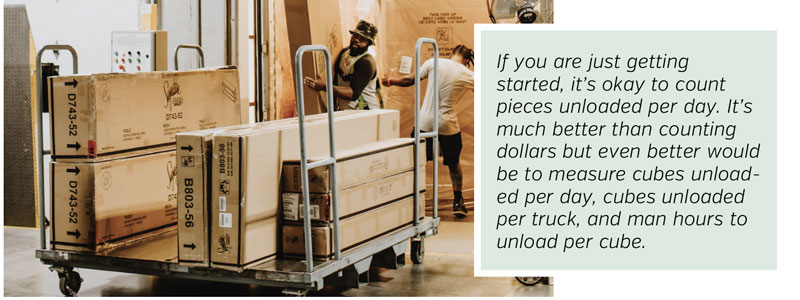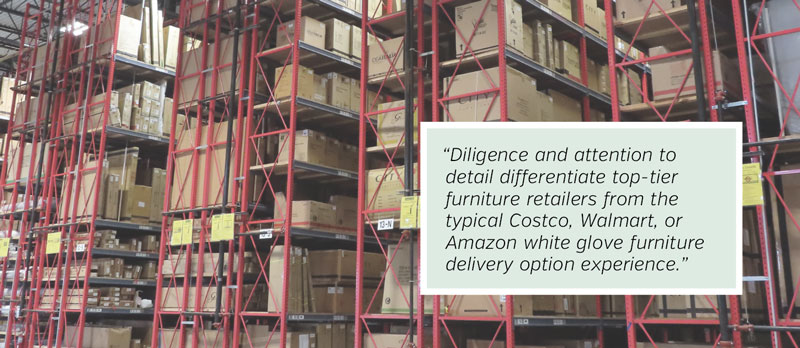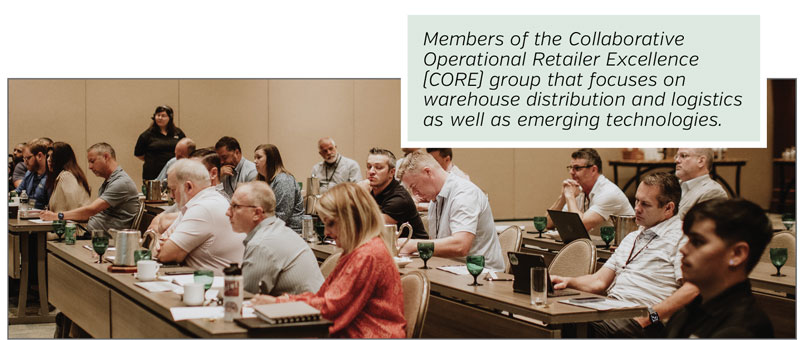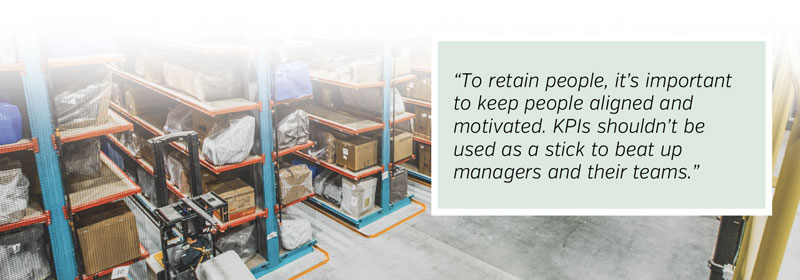Interview with Billy Lindler Jr., CEO at USSI
Tom Liddell looks at business challenges and opportunities home furnishings retailers are likely to face in
2025.
Ignoring important warehouse KPIs leaves furniture retailers' profits on warehouse floors. Measuring and
benchmarking
operational results across multiple retailers and DCs can be challenging, but fortunately, doing better is easy.
Furniture World asked Billy Lindler Jr. to share insights gleaned from his furniture operations performance
group, which
develops warehouse and delivery KPIs and discusses operations challenges and opportunities. Lindler’s company,
USSI
(www.ussipartners.com), provides warehouse storage equipment, including rack, shelving, mezzanines, and
automation.
Plus, USSI provides operational improvements consulting for existing facilities, new warehouse design, and
operational
efficiency assessments.
“I often say,” he recalled, “that I’ve yet to meet a furniture store owner or key retail executive who entered
the
furniture business because they dreamed of running a warehouse. As a result, most retailers in our industry tend
to
focus their attention on the front ends of their businesses.
“The problem with this is that most furniture store owners’ capital is tied up in inventory. Retailers should,
therefore, consider their warehouses as money in the bank. I spend a lot of time visiting retailers’ warehouses,
where I
often find the equivalent of money scattered all over the floor, with an unhealthy percentage of it damaged and
consisting of currencies that have lost much of their value.”
The CORE Initiative
Four and a half years ago, one of USSI’s customers, Alex Jaffe, the owner of El Paso-based Household Furniture,
invited
Lindler to present at a performance group meeting. As a result, operational leaders formed the Collaborative
Operational
Retailer Excellence (CORE) group. “The group focuses primarily on warehouse distribution and logistics,” said
Lindler.
“It looks at innovative and emerging technologies like AI, driverless material handling systems, and Autonomous
Mobile
Robot (AMR) devices that do cycle counting. So far, we’ve held meetings at Woodstock Furniture, Georgia
Furniture Mart,
CITY Furniture, and FDE. In 2025, we will meet at NFM at The Colony.”
“Using cubes instead of dollars as a reference is preferred to account for retailers with different product
mixes and
price point profiles.”
He explained that furniture retailers are looking to become more operationally efficient. “To do that, the CORE
group
also decided to establish a set of key performance indicators (KPIs) to benchmark operational results across
multiple
retail operations, initially in four major areas: Safety, Quality, Inventory and Performance.
“It soon became apparent that individual retailers in the group needed to standardize how they measure warehouse
KPIs.
Most important was to give up measuring them in dollars. The cost to move a sofa into a warehouse, store it,
retrieve
it, and then move it out is the same for an $800 sofa as for one that’s $10,000. Comparing the warehouse
efficiency of a
promotionally priced retailer with a designer-oriented store is like comparing the average sale at a Mercedes
dealership
with one that sells KIAs. The numbers don’t match up. Using cubes instead of dollars as a reference is preferred
to
account for retailers with different product mixes and price point profiles.
“Even measuring labor per month needs to be standardized by deciding what items to include. For example, should
administrative and management staff who may log lots of behind-the-desk time be included? Probably not.”
“When we performed an inventory analysis to determine the cube needed to meet future growth, we discovered that
20% of a
retailer’s cube was filled with merchandise that wasn’t displayed for sale.”
#1: Safety-Focused KPIs
“Everyone in the group agreed never to compromise safety, commonly measured as the number of days without
injury. The
problem was that there wasn’t a common definition of what constitutes an injury. The group decided to use
Workers’ Comp
Days Out—either an injury or an incident. That was the first definition. Two subsets of that KPI are Workers
Comp Light
Duty, for workers who sustain an injury but can still perform at some level. Another is Overall Workers’
Compensation
Cost, also a straightforward measure.
“Property damage to customers’ homes, vehicle damage, and liability claims are worth tracking, so the group
plans to
develop KPIs for these and progressively expand them outward.
“Other safety concerns probably won’t be assigned KPIs. I recall discussing a horrific incident involving a home
delivery driver at an HFA CEO Top 100 Summit some years ago. Do you remember the TV show called ‘Scared
Straight?’ It
was like that. These rare events don’t require KPI reporting. However, discussing them is valuable to remind our
CORE
members to do their due diligence, especially with companies and people who interact with customers in their
name. It
can’t be a one-and-done hiring thing."

#2: Quality-Focused KPIs
“These KPIs include First-Time Completion On Order, a warehouse and delivery performance measure tightly
connected with
customer satisfaction and repeat business. Also, Return Rate and First-Time Delivery Rate.
“Planned for future implementation are KPIs that track why deliveries weren’t successful. Calculating them is
somewhat
more nuanced but just as necessary.
“Let’s say one retailer has a return rate of 4%, another is at 3%, and a third is at 12%. Perhaps the third
retailer has
a real problem, or they aren’t comparing apples to apples. Maybe the third retailer’s KPI included a ‘didn’t
fit’
number. That should be a separate metric, especially if it isn’t the responsibility of ops to engage with
customers to
find out, for example, if a king-size bed will fit into a third-floor bedroom. Warehouse operations should not
be held
responsible for upstream errors in a retail organization.”
Returns Due to Damage: “Most retailers USSI works with already unbox, check, and deluxe/prep
case pieces and other
damage-prone categories before delivery. Some also plug in motion furniture to ensure mechanisms function
properly.
Others spot-check, especially if there is visible packaging damage. This diligence and attention to detail
differentiate
top-tier furniture retailers from the typical Costco, Walmart, or Amazon white glove furniture delivery option
experience.”

#3: Inventory KPIs
Lindler explained that Inventory Aging Turns is a vital KPI. Poor turn numbers can result from several factors.
“These
include inventory that’s not displayed on the retail floor; over-buying to take advantage of too-good-to-miss
deals;
having too many non-merchandisable odds and ends; and inventory that’s being held for future delivery.”
Overbuying. There are reasons to build inventory to meet anticipated demand. Certainly,
retailers over-inventoried two
months into the COVID pandemic found themselves in great shape. “A more usual result,” Lindler noted, “is low
inventory
aging turns and high carrying costs. My dad and USSI’s founder, Bill Lindler Sr., once told me about an extreme
example
of a retailer who bragged about getting a great deal on two container loads of knockdown bookcases. However,
when
inventory aging turns were calculated, it turned out that it would take years to clear them from the warehouse.
Great
buys are sometimes not so great. Run the numbers based on projected sales rate and consider true carrying cost.
USSI
customers are using Business Intelligence and Artificial Intelligence to make significant inventory management
improvements.”
Inventory That is Not Displayed: “Occasionally, furniture retailers contact us because they
mistakenly believe they are
running out of warehouse space and need to build a new facility. On one occasion, when we performed an inventory
analysis to determine the cube needed to meet future growth, we discovered that 20% of a retailer’s cube was
filled with
merchandise that wasn’t displayed for sale in any of their showrooms. Admittedly, that was an extreme case.
“Inventory not shown on the sales floor needs to be measured, and the CORE group is developing KPIs for this and
other
inventory metrics that will allow for easy comparison and benchmarking.”

Inventory in Reserve: “Retailers that furnish full rooms or entire homes often hold inventory in reserve to
accommodate
construction delays, delivery delays, or interior designers’ requests to deliver everything at once. Storing
inventory
longer than expected can be challenging to manage. When items are likely to be out of stock for a while,
transparent
conversations with customers can get them to agree to break an order up into two or more deliveries.
“For some retailers, especially on the high end, inventory held in reserve can be a big problem that requires
measurement and management intervention to avoid warehouses becoming customer-owned inventory storage
facilities.”
Inventory Cycle Count Frequency: “Most CFOs require quarterly or annual counts, but there is wide variation. We
have
clients that count weekly on a combined total of a million or more square feet of DC space. It’s not easy to do,
but
these retailers feel it’s worth committing to being able to tell customers with some certainty what’s available
in
inventory for sale.”
Transparency and Communication: “It’s the responsibility of operations to track inventory KPIs, identify problem
situations and bring them to the attention of, for example, the sales VP, CEO, or CFO responsible for deciding
how to
deal with nonproductive inventory situations.
“Of course, keeping lines of communication open can’t be a one-way street. Some retail owners can’t resist making
a
purchase that isn’t in sync with their warehouse teams. Or they decide to incorporate unusual items into their
merchandise mix. One that comes to mind is a furniture retailer who decided to add hot tubs without considering
the
delivery challenges. On most occasions, retailers who operate that way are not as operationally efficient as
they could
be.”
“If incentives are based only on pieces, crew members will likely gravitate toward a truck containing a bunch of
bed
rails that can all be put away at once.”
#4 Performance KPIs
“There are a whole host of performance measures,” he continued, “for example, total payroll for a DC as a
percentage of
delivered cubes; total payroll as a percentage of delivered pieces; or total payroll as a percentage of
delivered
dollars. A case can be made to calculate all three.
“Likewise, many retailers have excellent KPIs for route planning. They know that yesterday, for example, the
two-person
crew of Bob and Jim delivered 15 stops valued at $20,000. That’s worth knowing, but it’s more helpful to know
that they
made 15 stops and delivered 1,600 cubes and 22 pieces.
“Incentives affect performance in interesting ways. In the same way that salespeople have commission incentives,
the
warehouse staff should have performance incentives. Some USSI customers pay warehouse staff based on the
calculation of
the number of pieces and cubes moved. They are assigned a weekly target and paid a nominal per-hour bonus for
exceeding
it.
“Care must be taken when designing incentives because it’s possible to drive the wrong behaviors. If incentives
are
based only on pieces, crew members will likely gravitate toward a truck containing a bunch of bed rails that can
all be
put away at one time instead of a mixed-load Ashley truck with all kinds of different items that take more time
to
unload, inspect and store. Incentivizing warehouse personnel on the dollar value of merchandise put away may
have a
similar effect.”
The Future
“As our set of KPIs matures and develops, I expect that our business system software partners will include the
CORE
group’s KPI work in their offerings," Lindler predicted. “There is still much work to be done, but group members
have
already benefited, with one reporting an operating expense reduction from mid-double digits to the high single
digits.”
Getting Started with KPIs
Lindler observed that many furniture retailers don’t track essential operations KPIs to share with teams to
enable
continuous improvement.
“Any of these retailers can calculate warehouse KPIs manually using just a whiteboard and markers. Here’s an
example.
Let’s say on Monday, ‘W’ number of trucks are unloaded containing a total of ‘X’ confirmed pieces by a team of
‘Y’
people working ‘Z’ hours. That’s enough to calculate man-hours per truck.
“It’s easy to develop target numbers over time, such as the number of pieces unloaded per day, per truck, and the
number
of man-hours required per piece to unload.
“Crew members can unload many smaller items than large bulky ones in a given period. Even so, it’s still OK to
begin by
counting pieces. That’s better than calculating dollars unloaded per day, dollars unloaded per truck, and man
hours to
unload per dollar. But even better would be cubes unloaded per day, cubes unloaded per truck, and man hours to
unload
per cube.
“Some people manually track the time per customer pick-up. I’ve seen retail pickup areas where someone pushes a
timer
mounted on a wall when a car or truck pulls in, manually recording time per pickup. Having a whiteboard there
can make
sense for retailers with a substantial proportion of customer pickups.
“When getting started reporting KPIs, the bottom line is to use warehouse KPIs to measure inventory accuracy,
perfect
delivery percent, and even time to load per customer pick up in the same way you measure the sales per
salesperson,
sales per square foot, or sales per category. At the start of each day, these and other numbers should be shared
with
warehouse teams.”
Final Comments
“Working in a furniture warehouse is a tough job. It’s sometimes hot, sometimes cold, and always demanding. Order
picker
operators routinely move over 20,000 pounds of furniture per day—a different experience than in most other
industries.
To retain people, it’s important to keep people aligned and motivated. KPIs shouldn’t be used as a stick to beat
up
managers and their teams. Establish a culture of continuous improvement and leverage KPIs to motivate all levels
of the
organization to achieve operational excellence. One of USSI’s customers has a great saying, 'The pursuit of
perfection
achieves excellence.' Go get it!"
